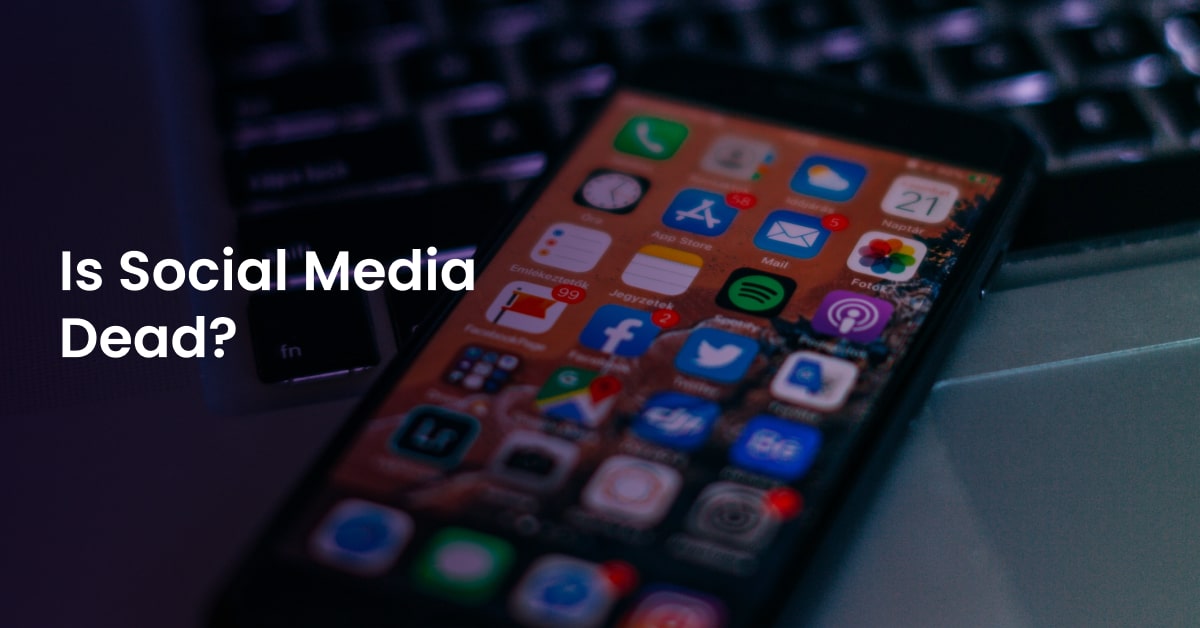Is social media as we know it dead? The signs of trouble are certainly getting more and more common.
Since 2021, Twitter has seen an exodus of users, advertisers pulling back, and even the end of its famous bird logo.
Facebook’s strategic effort to diversify into the metaverse has failed. As a result, Facebook has reverted to launching Threads, a platform widely seen as a Twitter clone.
Even TikTok, Gen Z’s favorite social media platform, has faced challenges within the U.S.
Meanwhile, government bodies are getting increasingly aggressive in responding to online services, including social media platforms.
Each of these individual social media companies’ struggles prompts the question: is social media dead? Let’s explore the current scenario and understand the alternatives for the future of social media.

The Decline And Fall Of Social Media
Social media platforms have been declining for years, depending on who you ask and which platform you prefer. It’s difficult to generalize about the fate of social media because there are so many different networks to choose from. One estimate shows that there are over 100 active social media services today. Even more significantly, Forbes reports that there are 4.9 billion social media users globally (i.e., about 62% of the population) as of 2023.
One way to answer “will social media marketing die” is to look at the numbers.
Yet only a handful of platforms have achieved significant success with over 500 million users. As of 2023, only 12 platforms have over 500 million monthly active users. The list includes well-known platforms like Facebook, YouTube, WhatsApp, TikTok, and Instagram, as well as others like WeChat, Snapchat, and Qzone. These large platforms have achieved outsized success and influence in the social media industry.
AI: Threats And Opportunities To The Future of Social Media
The rise of generative AI tools, especially large language models like chatGPT, also poses questions for social media. Some commentators like Jonathan Haidt and Eric Schmidt see only a downside with articles like “AI is About to Make Social Media (Much) More Toxic.” Such fears are one reason why governments are increasingly pursuing AI safety rules.
Generative AI, like social media itself, is in the eye of the beholder. It can also be used as a practical tool to increase engagement responsibly. Smart brands and agencies are already using it to lift efficiency. For more ideas on how to add AI to your workflow, see our post: 5 Use Cases for Generative AI in Publishing.
Twitter and Meta: The Decline of Giants
The social media platforms founded in the 2000s are encountering multiple challenges with growth.
To illustrate the challenge, we looked at a few recent developments at some of the largest social media companies.
Twitter: Struggling With Turmoil, Brand Changes, And Revenue Challenges
In 2021, Twitter earned 88% of its revenue from advertising. Following Elon Musk’s takeover of the company, chaotic layoffs, rebranding to X, and booming hate speech have advertisers heading for the doors. In November 2022, Omnicom Media Group recommended that its clients pause advertising spending on the platform due to brand safety concerns. Large companies, including General Motors and Volkswagen, are also pulling back from the platform.
The answer to “is social media marketing dead?” depends partly on how you’ve used your resources. If you’ve put all your resources into Twitter, you’re probably very worried about the future of your social media marketing efforts.
Pre-Tax Income Falls During The Pandemic
While the chaos following Elon Musk’s takeover has grabbed the headlines, the business’s fundamentals have suffered for years. The company reported a negative $50 million pretax income in 2020 and a negative pretax income of $411 million in 2021, and that’s before all the Elon Musk drama and the departure of nearly half of their advertisers.
We don’t know if Twitter will recover after suffering many blows, including losing thousands of employees. According to a December 2022 survey, Twitter is forecast to lose millions of users in 2023 and 2024. With declining users and concerned advertisers, Twitter’s future is uncertain. It’s time to find alternative platforms and channels to meet our online growth goals.
Bans and Restrictions
More recently, in August 2024, the Brazilian Supreme Court ordered the suspension of X in the country after the platform missed a deadline to appoint a legal representative in Brazil.
The conflict originated in April when the court mandated the suspension of numerous accounts for spreading false information—an action that Musk criticized as censorship.
The ruling affects over 20,000 internet providers, requiring them to block the use of virtual private networks (VPNs) to access X. Additionally, a daily fine of R$50,000 (£6,800) is imposed on individuals and companies attempting to bypass the block using VPNs.
Meta’s User Growth Slows While Metaverse Spending Hurts The Bottom Line
With over one billion users, Facebook is still regarded as one of the most powerful social media platforms. However, The early years of dramatic growth in users and revenue are slowing due to a few developments.
Facebook’s growth, while still significant, is falling substantially. From 2020 to 2023, the platform grew monthly active users from 2.6 billion to 2.9 billion, according to Statista. Adding 300 million users over three years sounds impressive until you compare it to the platform’s past. From 2015 to 2017, the platform grew from 1.4 billion to 2.1 billion users (i.e., 700 million users).
Metaverse Spending Spiraling Out Of Control
The Information reports that Facebook has spent over $36 billion on the metaverse since 2019. That’s greater than the company’s entire operating expenses for 2019 – $33.9 billion! This level of spending is starting to approach “bet the company’s future” territory. So far, this initiative has delivered little to the company’s bottom line.
If this spending continues, Google’s experience may be instructive. Like Facebook, Google has historically earned most of its revenue from advertising. Over the years, Google has spent heavily on high-risk “moonshot” projects that lost over $800 million by 2016. It’s true that these investments might pay off at some point. All we know for certain is most of these efforts have made minimal contributions to the company’s performance.
Competition Driven Innovation
Aside from its metaverse initiatives, Facebook’s innovation in its core social media platforms is limited. Recent changes seem to be driven by a desire to compete with TikTok. As Bloomberg reported, Facebook assumes its users want a “TikTok clone.” Changes to the Facebook experience and Instagram have been attributed to the company’s desire to compete with TikTok.
Developing new features solely to compete with rivals has merit. Yet, it may also suggest a lack of creativity in the platform’s ideas. These efforts to copy features haven’t been a success with the platform’s users. The “Make Instagram Instagram Again” petition on Change.org has attracted over 335,000 signatures. The petition demands the return of chronological timelines, an algorithm that favors photos, and greater responsiveness to Instagram users. This type of negative feedback signals significant discontent.
The End of Organic Reach
Brands, organizations, and creators using Meta platforms like Facebook and Instagram face declining organic reach, with only 5.2% of followers typically seeing unpaid content on Facebook. On Instagram, posts without paid boosts are similarly overshadowed by ads. Nearly 83% of marketers plan to increase social media ad spending, further diminishing organic visibility.
The pay-per-engagement model also overwhelms users with excessive ads. Recently, the European Commission accused Meta of violating EU laws by charging users for ad-free versions of Facebook and Instagram, forcing them to either pay or consent to data collection, in breach of the Digital Markets Act.
The Main Drivers Of Social Media Decline
While Facebook and Twitter’s problems have dominated the headlines recently, the problems in social media go beyond these companies. Several significant trends negatively impact large, established social media platforms. Increased competition and regulatory environment changes are fundamentally altering social media conditions.
Factor 1: Losing Competition For Attention

Without highly engaged users, social media companies cannot thrive. Unfortunately, older established social media companies need help to innovate. The most significant competition has come from TikTok in the past years.
Founded in 2016, the social media app has experienced dramatic growth through the pandemic years. At the end of 2019, the video-sharing platform had an estimated 500 million users. By late 2022, the Business of Apps estimated the platform has over 1.5 billion users. The platform is currently dominated by users under 30, who represent 63% of users.
Mastodon, a social platform based in Germany, has also experienced significant growth in 2022, mainly at the expense of Twitter. By March 2023, the platform had 10 million users (up from 2.5 million in November 2022). Established in 2016, Mastodon’s relatively decentralized format and lack of advertising features distinguish it from other social platforms.
Discord is another platform that’s successfully creating engaging digital communities. The text and audio interaction app has become popular in the gamer community. The Business of Apps estimates Discord had 13.5 million active servers in 2021, up from 4.4 million in 2018. While small, Discord is an interesting example of a platform growing with niche audiences.
The growing popularity of alternative social websites and apps suggests new possibilities for brands and publishers. Running a Discord server may help you to appeal to more Gen Z users. These competing community experiences also demonstrate an appetite for more curated content and experiences.
Learning the ins and outs of new digital platforms can be worthwhile. Yet, don’t overlook how resource-intensive it can be to start a new community in ideal conditions. The social strategies that work on Facebook, Twitter, or Instagram will not fully apply to Discord, TikTok, or Mastodon. However, your understanding of your audience’s interests and preferences is transferable, regardless of the platform you use.
Factor 2: Government Pressure Hurts Social Media’s Business Model

Government agencies and elected officials are scrutinizing social media apps more and more closely. Ten years ago, social media was typically viewed as a fun experience and a way to connect with friends and family. In recent years, governments have become seriously concerned about the ill effects of social media.
Government pressure and interest in social media platforms and other technologies has recently increased. In 2018, Facebook improperly shared the data of over 87 million users with political consultancy Cambridge Analytica, leading to a major scandal that brought Mark Zuckerberg before the U.S. Congress. More recently, in July 2023, the U.S. government and several states filed a groundbreaking lawsuit against Meta, accusing the company of deliberately designing addictive platforms that prioritize profits while causing serious mental health issues.
Also in 2023, CNBC reported that Congress is investigating Threads, the new social media platform created by Meta, specifically looking at content moderation.
Concerns about the adverse effects of social media is an international phenomenon. The European Parliament published an in-depth analysis of the critical social media risks to democracy in 2021. As research continues, traditional social media companies may come under additional pressure. These concerns are not the only threat to traditional social media platforms.
The following regulatory changes have put pressure on the largest social media companies. In 2018, the European Union’s General Data Protection Regulation (GDPR) came into effect. While not targeted exclusively at social media, the regulations require greater protection of personal data, which is the stock in trade of social media. The California Consumer Privacy Act (CCPA) has raised the bar further in the US. These new expectations impose costs for non-compliance as well. In 2022, the California Attorney General announced a $1.2 million settlement with a major retailer relating to the CCPA.
Most social media companies earn the lion’s share of their revenue from advertising. That advertising revenue largely depends on user data. As regulations tighten on privacy and consumer data, other companies are seeing opportunities. Apple’s increased emphasis on privacy measures may cost Facebook social media companies an estimated $10 billion in lost revenue.
Social Media Is Dead…What is the Future of Social Media?
The death or decline of a few of the largest social media companies is the most significant change to digital marketing in a decade. Many marketers have built their entire careers around social media expertise. As a result, it’s no surprise many marketers are anxiously asking is social media marketing dead?
The answer to that question depends on where you focus your efforts.
One option is building a presence on smaller or newer social media platforms like Discord, Mastodon, or Reddit. If there is a large potential audience for your brand on those sites, there is some value in building a presence there. However, moving from one social media platform to another has drawbacks. Fundamentally, brands do not set the rules on these platforms. It can be challenging to ensure brand safety in an environment where you have limited control, and minimal first-party data.
The Future Of Social Media Isn’t What You Would Expect
In today’s ever-changing digital landscape, depending solely on social media for audience engagement carries major risks. From algorithm changes to unexpected bans, brands are at the mercy of these platforms’ unpredictability. Building your own community platform gives you complete control, allowing for deeper, more sustainable audience connections.
Allow your audience to interact with you and meet people who have the same interests and values, while increasing retention and website monetization. With Arena Community, you can launch your online community inside your website in a few minutes, with several features that increase engagement, like group chat, live blog, polls, Q&As and much more. Learn more about Arena Community and how you can revolutionize audience engagement.



